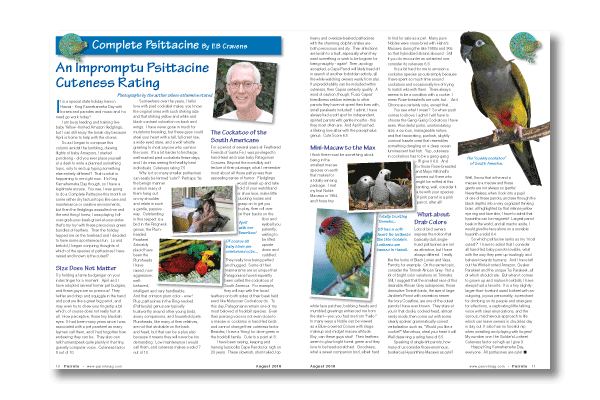
Complete Psittacine By EB Cravens
It is a special state holiday here in Hawaii - King Kamehameha Day with horses and parades and music and 'no need go work today'!
I am busy feeding and training five baby Yellow -fronted Amazon fledglings, but I can still enjoy the break day because April is home to help with the chores.
So as I began to compose this column amidst the fumbling, clawing flights of baby Amazons, I started pondering - did you ever place yourself at a desk to write a planned something topic, only to end up typing something else entirely different? That is what is happening to me right now. It’s King Kamehameha Day though, so I have a legitimate excuse. You see, I was going to do a Complete Psittacine this month on some rather dry factual topic like care and maintenance or creative environments, but then the fledglings assaulted me and the next thing I knew, I was playing 'roll-over-grab-your-beak-growl-at-your-sister-that’s my toy' with these precocious green bundles of feathers. Then the holiday tapped me on the forehead and I decided to have some spontaneous fun. Lo and behold, I began conjuring thoughts of which of the species of psittacines I have raised and known is the cutest?
Read more in the magazine…
Buy a copy now!
BACK
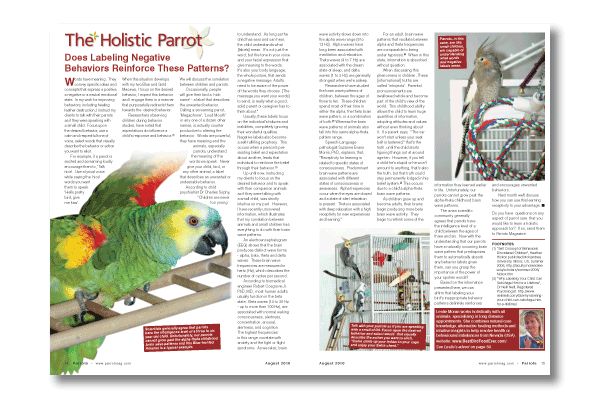
The Holistic Parrot by Leslie Moran
Words have meaning. They convey specific ideas and concepts that express a positive, a negative or a neutral emotional state. In my work for improving behaviors, including healing feather destruction, I instruct my clients to talk with their parrots as if they were speaking with a small child. Focus upon the desired behavior, use a calm and respectful tone of voice, select words that visually describe the behavior or action you want to elicit.
For example, if a parrot is excited and screaming loudly encourage them to, ‘Talk nice’. Use a lyrical voice while saying the ‘nice’ words you want them to speak. ‘Hello pretty bird, give me kiss’. When this situation develops with my two Blue and Gold Macaws, I focus on the desired behavior, I expect this behavior and I engage them in a manner that purposefully redirects them towards the desired behavior.
Researchers observing children during behavior studies, have noted that expectations do influence a child’s response and behavior. We will discuss the correlation between children and parrots.
Read more in the magazine…
Buy a copy now!
BACK
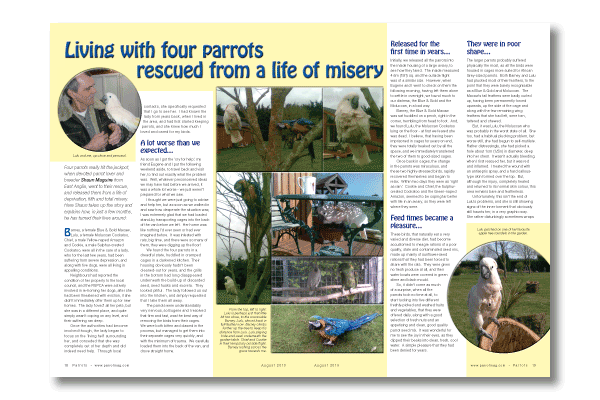
Four parrots really hit the jackpot, when devoted parrot lover and breeder Shaun Maguire from East Anglia, went to their rescue, and released them from a life of deprivation, filth and total misery. Here Shaun takes up the story and explains how, in just a few months, he has turned their lives around:
Barney, a female Blue & Gold Macaw, Lulu, a female Moluccan Cockatoo, Chief, a male Yellow-naped Amazon and Cookie, a male Sulphur-crested Cockatoo, were all in the care of a lady, who for the last few years, had been suffering from severe depression, and along with five dogs, were all living in appalling conditions.
Neighbours had reported the condition of her property to the local council, and the RSPCA were actively involved in re-homing her dogs, after she had been threatened with eviction, if she didn’t immediately offer them up for new homes. The lady ‘loved’ all her pets, but she was in a different place, and quite simply wasn’t coping on any level, and their suffering ran deep.
Once the authorities had become involved though, the lady began to focus on the ‘living hell’ surrounding her, and conceded that she was completely out of her depth and did indeed need help. Through local contacts, she specifically requested that I go to see her. I had known the lady from years back, when I lived in the area, and had first started keeping parrots, and she knew how much I loved and cared for my birds.
Read more in the magazine…
Buy a copy now!
BACK
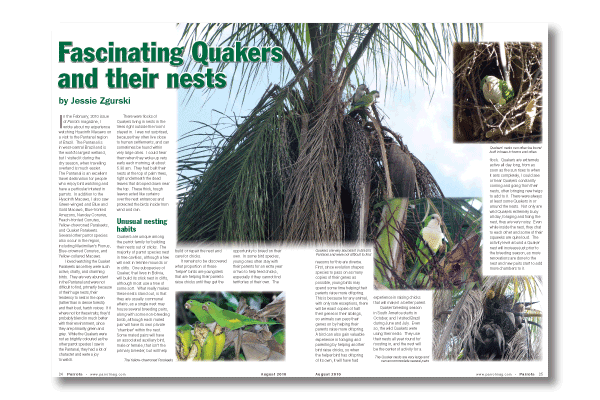
by Jessie Zgurski
In the February, 2010 issue of Parrots magazine, I wrote about my experience watching Hyacinth Macaws on a visit to the Pantanal region of Brazil. The Pantanal is in west-central Brazil and is the world’s largest wetland, but I visited it during the dry season, when travelling overland is much easier. The Pantanal is an excellent travel destination for people who enjoy bird watching and have a particular interest in parrots. In addition to the Hyacinth Macaws, I also saw Green-winged and Blue and Gold Macaws, Blue-fronted Amazons, Nanday Conures, Peach-fronted Conures, Yellow-chevroned Parakeets, and Quaker Parakeets. Several other parrot species also occur in the region, including Maximilian’s Pionus, Blue-crowned Conures, and Yellow-collared Macaws.
I loved watching the Quaker Parakeets since they were such active, chatty, and charming birds. They are very abundant in the Pantanal and were not difficult to find, primarily because of their huge nests, their tendency to nest in the open (rather than in dense forests) and their loud, harsh voices. If it where not for these traits, they’d probably blend in much better with their environment, since they are primarily green and grey. While the Quakers were not as brightly coloured as the other parrot species I saw in the Pantanal, they had a lot of character and were a joy to watch.
There were flocks of Quakers living in nests in the trees right outside the room I stayed in. I was not surprised, because they often live close to human settlements, and can sometimes be found within very large cities. I could hear them when they woke up very early each morning, at about 5.30 am. They had built their nests at the top of palm trees, right underneath the dead leaves that drooped down near the top. These thick, tough leaves acted like curtains over the nest entrances and protected the birds inside from wind and rain.
Read more in the magazine…
Buy a copy now!
BACK
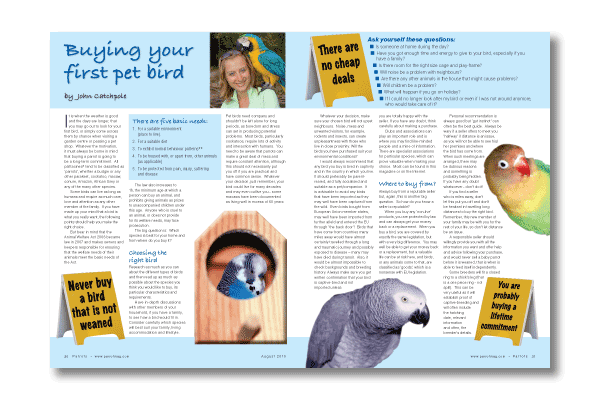
by John Catchpole
It is when the weather is good and the days are longer, that you may go out to look for your first bird, or simply come across them by chance when visiting a garden centre or passing a pet shop. Whatever the motivation, it must always be borne in mind that buying a parrot is going to be a long-term commitment. All psittacines tend to be classified as ‘parrots’, whether a budgie or any other parakeet, cockatoo, macaw, conure, Amazon, African Grey or any of the many other species.
Some birds can live as long as humans and require as much care, love and attention as any other member of the family. If you have made up your mind that a bird is what you really want, the following points should help you make the right choice.
But bear in mind that the Animal Welfare Act 2006 became law in 2007 and makes owners and keepers responsible for ensuring that the welfare needs of their animals meet the basic needs of the Act.
The law also increases to 16, the minimum age at which a person can buy an animal, and prohibits giving animals as prizes to unaccompanied children under this age. Anyone who is cruel to an animal, or does not provide for its welfare needs, may face prosecution.
The big question is: Which species is best for your home and from where do you buy it?
Read more in the magazine…
Buy a copy now!
BACK
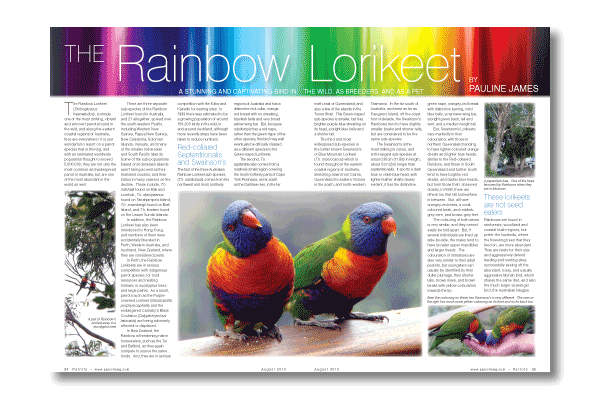
by Pauline James
A stunning and captivating bird in the wild, as breeders, and as a pet
The Rainbow Lorikeet (Trichoglossus haematodus), is simply one of the most striking, vibrant and extrovert parrots found in the wild, and along the eastern coastal regions of Australia, they are everywhere! It is just wonderful to report on a parrot species that is thriving, and with an estimated worldwide population thought to exceed 5,000,000, they are not only the most common and widespread parrot in Australia, but are one of the most abundant in the world as well.
There are three separate sub-species of the Rainbow Lorikeet found in Australia, and 21 altogether, spread over the south-western Pacific, including Western New Guinea, Papua New Guinea, New Caledonia, Soloman Islands, Vanuatu, and many of the smaller Indonesian and South Pacific Islands. Some of the sub-populations based on Indonesian islands aren’t faring so well as their mainland cousins, and their status in many cases is on the decline. These include, T.h. mitchelli found on Bali and Lombok, T.h. djampeanus found on Tanahjampea Island, T.h. rosenbergii found on Biak Island, and T.h. forsteni found on the Lesser Sunda Islands. In addition, the Rainbow Lorikeet has also been introduced to Hong Kong, and numbers of them were accidentally liberated in Perth, Western Australia, and Auckland, New Zealand, where they are considered pests.
Read more in the magazine…
Buy a copy now!
BACK






